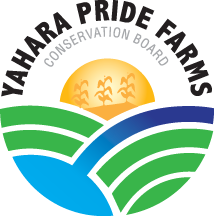Certification Program
The purpose
Yahara Pride Certification is a proactive program designed to help farmers identify the strengths and weaknesses of their farming system, facilities, and landscapes. This voluntary, non-governmental program helps farmers both document how their operation protects soil and water quality, and identify high-risk situations and practices that need to be modified. Yahara Pride Farms is committed to working with farmers, ag suppliers, and agency personnel to reduce risks and protect farm heritage.
Why it’s important
While farmers and landowners throughout Wisconsin are under increasing pressure to reduce non-point sources of nutrients and sediments to waters of the state, farmers living in the Yahara Watershed are under an even higher level of scrutiny. This is because the Yahara Watershed surrounds the urban development of Madison, which flows into a series of five lakes, each showing signs of excessive phosphorus and sediment loading. Modeling efforts have been conducted by a variety of private and public agencies over the year; a 2011 study concluded that agricultural sources accounted for 90% of the sediment and 84% of the phosphorus entering the lakes.
Why farmers should be involved and concerned
- Agencies and the non-farm public are working on reducing phosphorus pollution into these lakes and much of their attention is focused on farms and farming practices.
- Farmers have the best understanding of best practices to sustain farming systems and need to be the lead in identifying solutions that protect water quality and that are sustainable for their farms and the future of agriculture.
- We all want and expect clean water (both groundwater and surface waters). To accomplish this goal, both urban and rural entities need to work together to ensure the sustainability of agriculture in the region.
This farmer-led certification program allows farmers and agri-business to be proactive and to take the lead in reducing nonpoint pollution, while also finding the solutions that are best suited for farmers’ individual operations. The certification program is based on the belief that farmers are committed to feeding the world, while protecting land and water for future generations.
What the program measures
Our Conservation Resource Managers (CRM), Joe Connors and Dennis Frame, score farm operations by:
- Assessing facilities and non-permeable areas
- Analyzing crop and soil fertility program and nutrient management plan
- Evaluating field conditions through a walk-over
All three aspects of the operation are then individually scored in a final report. Operations that achieve 80% or more of the available points become “Yahara Pride Certified”, and get special certification benefits.
How the program works
Our certification process is designed to be flexible; depending on the season, schedules, and how an individual operation works, the following steps can happen in any order:
Assessing the facilities and non-permeable areas
The CRM will start by evaluating your facilities and non-permeable areas using a survey designed to determine environmental risks from six areas of the operation:
- the farmstead
- pesticide, fertilizer storage & handling
- petroleum storage and handling
- farm and household waste removal
- manure storage
- silage leachate
Analyzing the crop and soil fertility program and nutrient management plan
You and a CRM will have a conversation about how your operation determines and implements your nutrient application plan. It is not an evaluation of compliance with rules and regulations, but more an evaluation of how you establish and implement the application of nutrients to the crops. The survey will determine how your farm establishes the nutrient needs, application rates, and application methods for each crop as well as information on record keeping, mapping, and soil conservation.
The CRM will evaluate your SNAP nutrient management plan. SNAP (Soil Nutrient Application Planner) is a free program and model developed by the University of Wisconsin to estimate environmental impacts based on the farming system and nutrient applications (rates, timing, and methods). This will evaluate your farm’s conservation, soil testing, and nutrient application plan, and provide both a current and historical overview of the farm and the farming practices utilized. If you do not yet use SNAP, or have a SNAP plan, the CRM will also be able to help.
Evaluating the field conditions
The walk-through evaluation confirms the data gathered through the assessment and further identifies areas of concern or exceptional practices. This step is probably the most important because it provides feedback on both the current farming system and on how well the model is predicting losses. It’s one thing to have a plan work (or not work) on paper. It’s another thing to walk the fields and see what is really happening on the farm. The evaluation will help determine if the current farming system and the conservation practices used on the operation are adequately controlling nutrient and sediment losses.
The result:
These three aspects of the operation are individually scored in a final report, which provides feedback on each step of the process. The report includes information on best management practices already used by the operation (feet of stream buffers, feet of grassed waterways, etc.). The report also contains a prioritized list of suggested changes to the farming system that the farmer could implement that would reduce the risk of nutrient and/or sediment loss.
The program is designed by farmers, for farmers, to improve their farming systems while determining the most economical solutions for their operations. Until we can control the weather, we can never eliminate the risks inherent to farming. But, where possible, we should modify our farming systems to be as protective of the environment as possible, while educating the non-farm public about our farming approach.
How do I become a Yahara Pride Certified Farmer?
A Yahara Pride Certified Farmer is an active participant that has gone through our certification program and has received a score of at least an 80%.. To get more information on this program, please contact us at info@yaharapridefarms.org.
